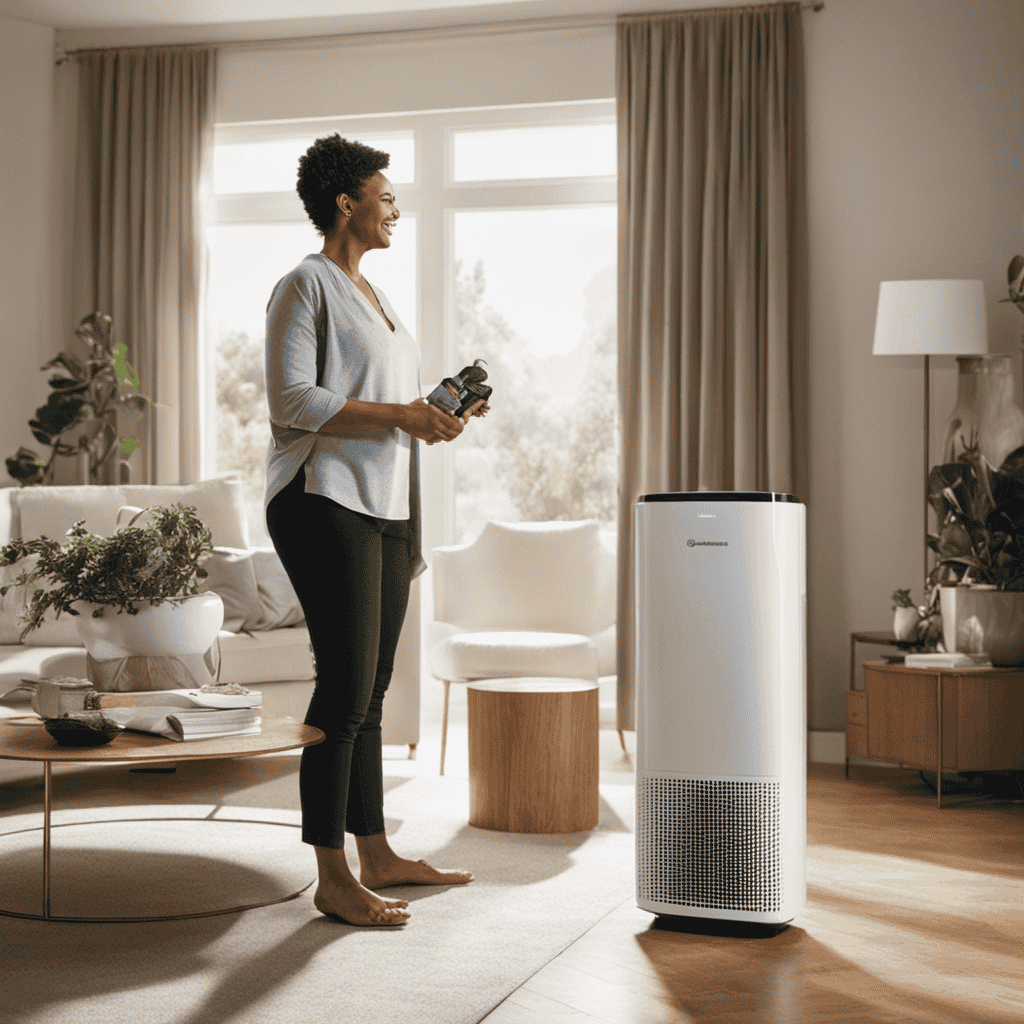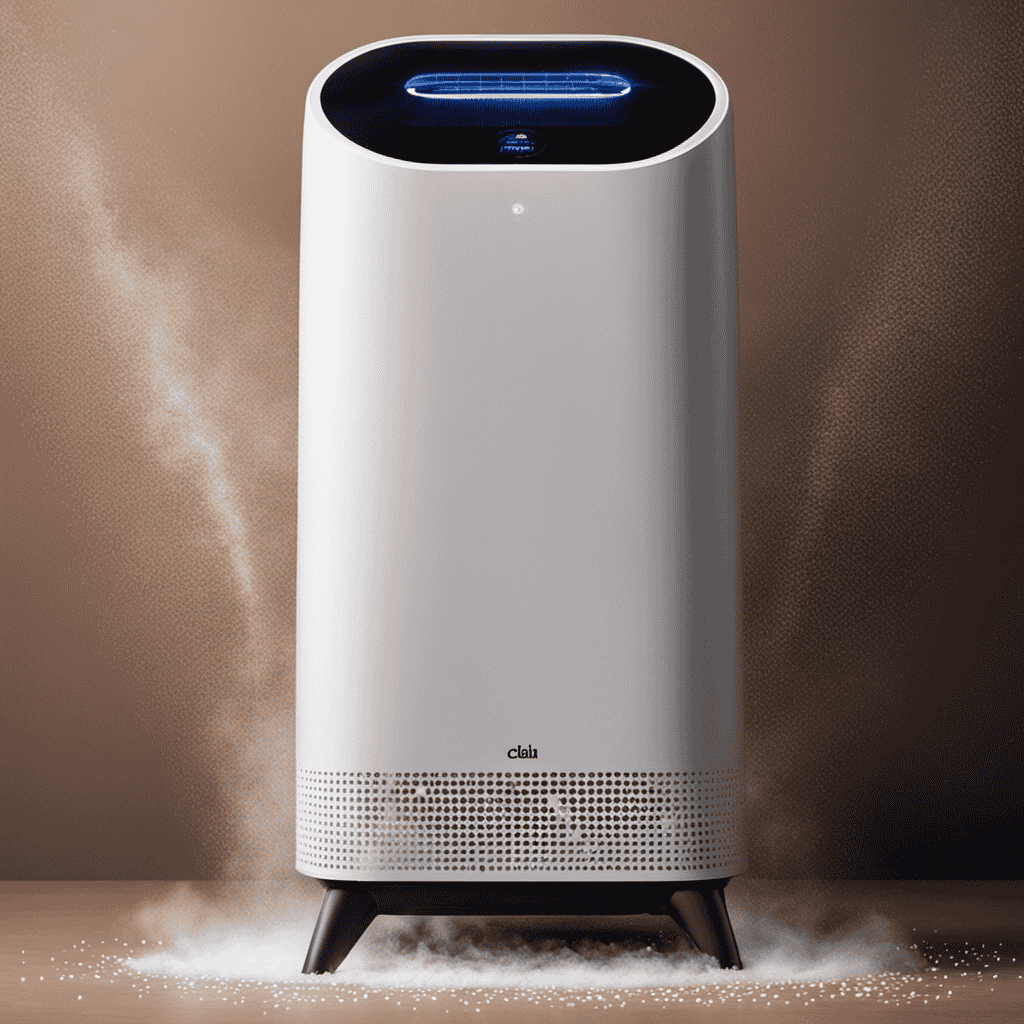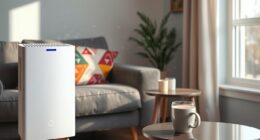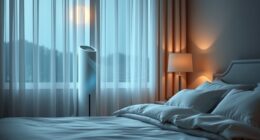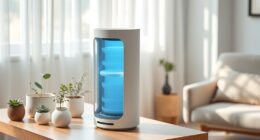Are you exhausted from inhaling pollutants and allergens in your home? Search no more!
In this article, I will guide you through the process of purchasing a good air purifier. With my expertise and attention to detail, you’ll be able to make an informed decision.
Together, we will explore the different types of air purifiers, factors to consider before buying, and how to evaluate their performance.
Get ready to breathe cleaner, healthier air and improve your overall well-being.
Key Takeaways
- Consider your specific needs and preferences before choosing a type of air purifier.
- Balance affordability and effectiveness to make an informed decision.
- Check the Clean Air Delivery Rate (CADR) to understand efficiency.
- Follow manufacturer’s recommendations for optimal performance and filter replacements.
Types of Air Purifiers
Now let’s talk about the different types of air purifiers you can choose from.
When it comes to air purifiers, there are several types of filters to consider. The most common types include HEPA filters, activated carbon filters, and ionizers.
HEPA filters are highly efficient at capturing small particles like dust, pollen, and pet dander. They are often the go-to choice for those with allergies or asthma.
Activated carbon filters, on the other hand, are great for removing odors and harmful chemicals from the air.
Ionizers work by releasing charged particles that attach to airborne contaminants, causing them to fall to the ground or stick to surfaces.
Each type has its pros and cons, so it’s important to consider your specific needs and preferences before making a decision.
With that said, let’s now delve into the factors you should consider before buying an air purifier.
Factors to Consider Before Buying
When it comes to buying an air purifier, there are several important factors to consider.
First and foremost is the price versus performance ratio. It’s crucial to find a balance between affordability and effectiveness in order to get the best value for your money.
Additionally, it’s important to consider the filter replacement frequency as this can greatly impact the long-term cost and maintenance of the air purifier.
Lastly, room size compatibility should be taken into account to ensure that the air purifier is capable of effectively purifying the air in the intended space.
Price Vs. Performance
The key is finding an air purifier that offers good performance for the price. When it comes to air purifiers, it’s important to consider the price range and the performance level. Here are some factors to keep in mind:
-
Price Range: Consider your budget and look for options within that range. Remember, a higher price doesn’t always guarantee better performance. Look for affordable models that offer good value for money. Consider the long-term costs, such as filter replacements, when evaluating the price.
-
Performance Level: Look for air purifiers that are effective in removing pollutants from the air. Check the Clean Air Delivery Rate (CADR) to understand the air purifier’s efficiency. Consider the size of the room and choose an air purifier that is suitable for that space.
By considering the price range and performance level, you can find an air purifier that meets your needs without breaking the bank.
Now, let’s discuss another important aspect: the filter replacement frequency.
Filter Replacement Frequency
Make sure you’re aware of how often you’ll need to replace the filters in your air purifier to maintain its effectiveness.
Proper air purifier maintenance is crucial for ensuring clean and healthy indoor air. Filters play a vital role in trapping and removing pollutants, allergens, and contaminants from the air. Over time, these filters become clogged and lose their efficiency, which can compromise the air purifier’s ability to provide clean air.
The frequency of filter replacement depends on various factors, such as the type of air purifier, the level of pollutants in your environment, and the manufacturer’s recommendations. It is important to follow these guidelines to ensure optimal performance.
Regularly replacing filters not only improves the air purifier’s efficiency but also helps in reducing the risk of respiratory issues and allergies. So, don’t overlook the importance of clean air and make sure to schedule regular filter replacements in your air purifier maintenance routine.
Room Size Compatibility
To ensure your air purifier effectively cleans the air in your space, consider the compatibility of the room size with the purifier’s coverage area. Room size compatibility is crucial for maximizing the air purifier’s effectiveness. Here are two key factors to consider:
-
Purifier Coverage Area: Check the manufacturer’s specifications to determine the recommended square footage that the air purifier can effectively cover. This information is usually provided in the product description or user manual.
-
Room Size: Measure the square footage of the room where you plan to use the air purifier. Make sure it falls within the purifier’s coverage area. If the room is larger, you may need multiple units or a larger purifier to effectively clean the air.
By ensuring the compatibility of the room size with the air purifier’s coverage area, you can optimize its effectiveness in purifying the air.
Now, let’s delve into the next important aspect of air purifiers: understanding air purifier filters.
Understanding Air Purifier Filters
Understanding air purifier filters is essential when choosing the right air purifier for your needs. Filters play a crucial role in capturing and removing airborne contaminants, ensuring clean and healthy air in your home or office. There are different types of filters available, each with its own unique properties and benefits. To help you visualize the differences, here is a comparison table:
| Filter Type | Description |
|---|---|
| HEPA Filters | Highly efficient at capturing small particles like dust, pollen, and pet dander. |
| Activated Carbon Filters | Effective at removing odor-causing molecules and harmful gases. |
| UV-C Filters | Utilize ultraviolet light to kill bacteria and viruses. |
Regular air purifier maintenance is crucial to ensure optimal performance. This includes cleaning or replacing the filters as recommended by the manufacturer. The benefits of air purifiers are countless, from reducing allergy symptoms to improving overall indoor air quality. As we move on to the next section, it’s important to consider not only the filter type but also the noise levels and energy consumption of an air purifier.
Noise Levels and Energy Consumption
When it comes to air purifiers, noise levels and energy consumption are important factors to consider.
The noise level of an air purifier can affect your comfort and sleep, while energy consumption can impact your electricity bills.
In this discussion, we will explore the relationship between noise and efficiency, as well as energy-saving options to help you make an informed decision when purchasing an air purifier.
Noise Vs. Efficiency
The noise level of an air purifier is important to consider when determining its efficiency. A noisy air purifier can be distracting and may hinder your ability to concentrate or sleep. To ensure a quiet and efficient air purifier, consider the following:
-
Noise reduction techniques:
-
Look for air purifiers with noise reduction features such as noise-cancelling technology or insulated motor compartments.
-
Choose air purifiers with lower decibel ratings, preferably below 50 dB, for a quieter operation.
-
Air purifier maintenance:
-
Regularly clean or replace filters to prevent clogging and reduce strain on the motor, which can lead to increased noise levels.
-
Keep the air purifier free of dust and debris to maintain optimal performance and minimize noise.
By prioritizing noise reduction and proper air purifier maintenance, you can ensure a quiet and efficient air purifier that effectively cleans your indoor air.
Now, let’s explore energy-saving options for air purifiers.
Energy-Saving Options
To save energy, you can opt for an air purifier with an eco-mode feature. These energy-saving options not only reduce your carbon footprint but also help you save on your electricity bills. Eco-mode typically adjusts the fan speed and power consumption based on the air quality in your surroundings. This feature ensures that the purifier operates efficiently while maintaining air freshness.
Consider the table below for a comparison of popular air purifiers with energy-saving features:
| Air Purifier | Eco-Mode Feature | Energy Consumption |
|---|---|---|
| Brand A | Yes | Low |
| Brand B | Yes | Moderate |
| Brand C | No | High |
As you can see, opting for an air purifier with an eco-mode feature can significantly reduce energy consumption, making it a more eco-friendly option. It’s important to choose an air purifier that not only meets your air quality needs but also helps you save energy in the long run.
Room Size and Coverage Area
Make sure you measure the size of your room and check the coverage area before purchasing an air purifier. This is crucial to ensure that the purifier you choose is capable of effectively cleaning the air in your space.
When considering room size and coverage area, keep in mind the following:
-
Filter types: Different air purifiers utilize different types of filters, such as HEPA filters, activated carbon filters, or ionizers. The effectiveness of these filters can vary, so understanding the specific needs of your room is important.
-
Air quality standards: Familiarize yourself with the air quality standards recommended by organizations such as the Environmental Protection Agency (EPA) or the World Health Organization (WHO). These standards can help you determine the level of air purification required for your room.
Key Features to Look for
When considering which air purifier to buy, it is important to look for key features that will meet your specific needs. These features can greatly impact the effectiveness and efficiency of the air purifier. Here are some key features to consider:
| Key Feature | Description | Pros | Cons |
|---|---|---|---|
| HEPA Filter | High Efficiency Particulate Air (HEPA) filters can capture tiny particles as small as 0.3 microns, including dust, pollen, and pet dander. | – Highly effective at removing allergens and pollutants |
- Improves indoor air quality
- Long filter lifespan | – May require regular filter replacements
- Higher initial cost |
| Activated Carbon Filter | Activated carbon filters can effectively remove odors, gases, and volatile organic compounds (VOCs) from the air. | – Eliminates unpleasant odors - Removes harmful chemicals
- Extends filter life | – Limited effectiveness against larger particles
- May need frequent replacement |
| UV-C Light | UV-C light can destroy viruses, bacteria, and mold spores by altering their DNA structure. | – Kills germs and bacteria - Helps prevent the spread of airborne diseases
- Low maintenance | – Limited effectiveness against allergens and particles
- May produce ozone |
Evaluating Air Purifier Performance
By evaluating the performance of different air purifiers, you can determine which one will best meet your needs. When it comes to assessing air purifier performance, there are two key factors to consider: air quality measurement and allergen removal effectiveness.
To ensure that you’re investing in an air purifier that truly improves your indoor air quality, it’s crucial to look for models that have accurate air quality measurement capabilities. These purifiers typically come with sensors that can detect and display the levels of pollutants in your home, such as dust, pollen, and VOCs (volatile organic compounds).
In addition to air quality measurement, allergen removal effectiveness is another important aspect to consider. Look for air purifiers that are specifically designed to remove common allergens like pet dander, pollen, and mold spores. The best air purifiers use advanced filtration systems, such as HEPA filters, to effectively capture and trap these allergens, ensuring cleaner and healthier air for you and your family.
Comparing Brands and Models
Comparing different brands and models can help you determine which one is the best fit for your specific needs.
When it comes to air purifier performance comparison, it is essential to conduct a thorough brand reputation analysis. A reliable and reputable brand is more likely to deliver a high-performing air purifier. Look for brands that have been in the market for a significant period and have positive customer reviews.
Additionally, consider the specific models offered by each brand. Look for features such as the type of filtration system, the CADR (Clean Air Delivery Rate) ratings, and the coverage area. These factors will give you a better understanding of the air purifier’s performance and its ability to effectively clean the air in your space.
Price Range and Budgeting
When it comes to purchasing an air purifier, it’s important to set a budget and compare price ranges to ensure you’re getting the best value for your money.
Setting a budget will help narrow down your options and prevent overspending.
Comparing price ranges allows you to see the different features and capabilities offered by various models within your budget, helping you make an informed decision.
Setting a Budget
To make sure you find the perfect air purifier for your needs, it’s important to set a budget that you’re comfortable with. When it comes to air purifiers, there are a variety of features and maintenance considerations to keep in mind. Here are two important factors to consider:
-
Air Purifier Features:
- Look for a purifier with a HEPA filter, as it effectively captures small particles and allergens.
- Consider additional features such as activated carbon filters for odor removal or UV-C light for germ-killing capabilities.
-
Air Purifier Maintenance:
- Check the filter replacement frequency and cost, as this will impact long-term maintenance expenses.
- Consider the noise level of the purifier, especially if you plan to use it in a bedroom or office space.
Comparing Price Ranges
To find the air purifier that fits within your budget, you’ll want to take a closer look at the different price ranges available.
When comparing price ranges, it’s important to consider the filter types and customer reviews. Different air purifiers come with different types of filters, such as HEPA filters or activated carbon filters.
HEPA filters are known for their ability to remove small particles like dust, pollen, and pet dander from the air. On the other hand, activated carbon filters are effective at removing odors and chemicals.
Customer reviews can give you valuable insights into the performance and durability of the air purifier. Look for reviews that mention the effectiveness of the filters and the overall satisfaction of customers.
Tips for Maintaining and Cleaning Your Air Purifier
Regularly cleaning and maintaining your air purifier is essential for optimal performance. As someone who has extensively researched the best cleaning techniques and maintenance schedule, I can confidently share some tips to help you keep your air purifier in top condition.
Here are some important steps to consider:
-
Cleaning Techniques:
-
Start by turning off and unplugging your air purifier.
-
Remove the filters and vacuum them to remove dust and debris.
-
For thorough cleaning, use a mild detergent and warm water to wash the filters.
-
Allow the filters to dry completely before reinstalling them.
-
Maintenance Schedule:
-
Ideally, clean the filters every 3 months, or more frequently if you have pets or live in a polluted area.
-
Check the manufacturer’s instructions for specific maintenance guidelines.
-
Regularly inspect the air purifier for any signs of wear or damage.
-
Replace the filters as recommended by the manufacturer to ensure optimal performance.
Frequently Asked Questions
Are Air Purifiers Safe to Use Around Pets and Children?
Air purifiers are generally safe to use around pets and children, but there are potential risks to consider. Some purifiers emit ozone, which can be harmful, so it’s important to choose one that is certified ozone-free.
Can an Air Purifier Help With Allergies and Asthma?
Yes, an air purifier can help with allergies and asthma. It filters out allergens and pollutants from the air, improving respiratory conditions. It also enhances sleep quality by removing airborne irritants.
How Often Do Air Purifier Filters Need to Be Replaced?
Air purifier filters typically need to be replaced every 6 to 12 months, depending on usage and the manufacturer’s guidelines. To choose the right replacement filter, consider the type of air pollutants you want to target and the specific model of your air purifier.
Can Air Purifiers Remove Odors From the Air?
Yes, air purifiers can effectively remove odors from the air. Different types of air purifiers, such as activated carbon filters, are designed specifically to target and eliminate odors, leaving the air fresh and clean.
Are There Any Potential Health Risks Associated With Using an Air Purifier?
Potential health concerns associated with using an air purifier include ozone emissions, noise pollution, and improper maintenance. It is important to research and choose an air purifier that effectively removes pollutants without causing harm.
Conclusion
In conclusion, purchasing a good air purifier requires careful consideration of various factors. From understanding different types of air purifiers to evaluating their performance, one must thoroughly research and compare brands and models.
Just like a skilled gardener who carefully tends to each plant, we must attentively maintain and clean our air purifiers to ensure their optimal performance. By doing so, we can create a clean and healthy indoor environment, akin to a vibrant garden flourishing with life.
Remember, investing in a good air purifier is an investment in your well-being.
